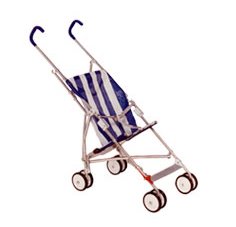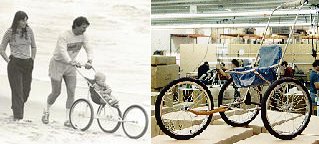Saturday
Oct182008
Stroller Theory
 Saturday, October 18, 2008 at 1:38PM
Saturday, October 18, 2008 at 1:38PM I was talking to my colleague Steve Montgomery today about my Unified Stroller Theory (it's not really unified, but I think theories sound better if called that, don't you?). The theory goes like this: I think the generational demographics outlined in Strauss and Howe's Generations: A History of America's Future, 1584 to 2069 and expanded on in The Fourth Turning—that is, that societal attitudes about children and the degree of nurturance they receive have swung from casual to protective—are reflected in baby stroller design from the 60s to today.
In the late 60s-early 70s, you saw minimal strollers like the first Maclaren, above—no protection for the kid, all about convenience for the parent--because that generation of parents had a casual attitude toward parenting. Entitled beneficiaries of the post-WWII economic boom, this generation of parents carried childhood self-centeredness into adulthood. They seemed to view their lives and goals as central, with kids added. The kids were pretty much part of whatever the parents were doing. I can remember one of my young college professors who had a small child. Like many young adults at the time who were busy "finding themselves," she continued her work as a painter and teacher, and didn't skip a beat—the kid went wherever she did. I remember seeing her one day, forging her way across a busy city street, thrusting that baby carriage out in front of her as she raced across, mid-block. I can still picture that red Maclaren B-01 in my mind's eye.
Even the jogging stroller (especially the jogging stroller) fits the theory. The inventor, journalist and jogger Phil Baechler, wanted to spend more time with his son, but instead of dropping everything to do that, he built a stroller that allowed him to bring the boy along with what he would be doing anyway. No judgement here on the quality of parenting—just observing that in these examples, the kid is included in the parent's life, rather than the parent's life being solely centered on the child. What I see today is a less easy-going and casual, and more intensely focused, style.
The 60s and 70s saw the rise in dual-income couples, the resulting phenomenon of latchkey kids, and the generation we have come to call Gen X—one that has gotten a very bad rap from the rest of us (much of the time undeserved, I might add). As these children grew up into risk-taking young people with a live-fast, die-young worldview, the indictment of them by society was severe. Portrayals of children in movies like Rosemary's Baby and The Omen reveal uneasiness, or at best, ambivalence. The worsening trend of lack of nurture continued until we became fed up with what we perceived as the "slacker" generation that resulted.
These days, we see a complete turnaround. Movies like Home Alone portray the kinds of kids we want to raise today—smart, resourceful, and assertive.
In the 90s, many of our kids began to go to school in uniforms. Education became a top political priority (in the 70s it was something that we lost focus on). Strollers began to be bulky, protective, and padded—the SUVs of the sidewalk—telegraphing the message that kids are precious cargo.
Most recently, kids are the focus of increasingly intense nurturing attention, and strollers have risen to cult objects that now telegraph this amped-up emotion. Considering our growing uncertainty in the face of perilous times, it's not surprising that our protectiveness is on steroids. The same obsession that goes toward Vuitton bags is now spent on outfitting our child with the latest. With a product like the Orbit, you are not buying a stroller, you are buying a system. We're even seeing a reprise of the old-fashioned pram (nostalgia is the last refuge of those enduring turbulent times).
 Katherine Bennett | Comments Off |
Katherine Bennett | Comments Off | tagged  demographics,
demographics,  design,
design,  strollers
strollers
 demographics,
demographics,  design,
design,  strollers
strollers 




